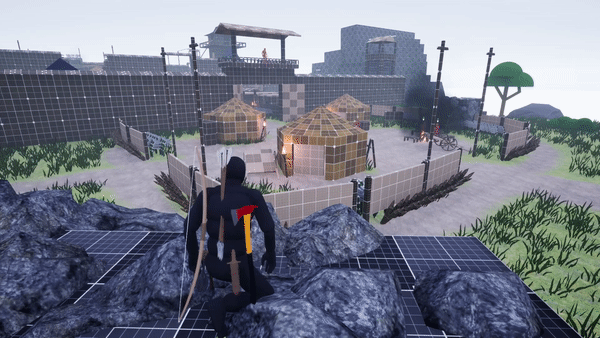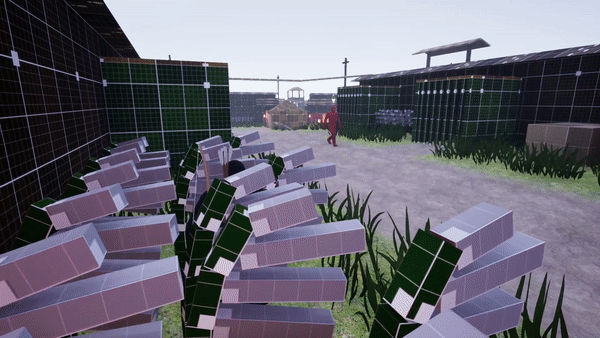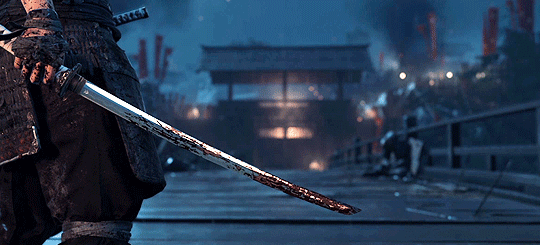top of page
Fort Azami
Level Designer
February 2022 - May 2022

Open-World Design
The level design allows for the player to come across the fort like any other open-world outpost available in Ghost of Tsushima, from multiple directions.
Supports multiple playstyles
From the honorable Samurai that fights their opponent head-on to the cunning Ghost that attacks from the shadows, this outpost supports both playstyles and gives the player agency for their choices.


Fully featured & Playable
Tall stealth grass, geo that blocks enemy line of sight, and other tools that the player can use are featured in this level. This level follows the rules and constraints Ghost of Tsushima's fort outposts use that make them exciting and rewarding to clear.

1

2

7 (Final)

1
1/7
Blockout Timelapse
Overview
Narrative/Setting: On his travels along the Musashi Coast in the Toyotama Region, Jin Sakai encounters Fort Azami, a once-Samurai-held defense camp now taken over by the Mongol invaders. The fort was meant to serve as security for the western coast of Tsushima Island and look after the local farmsteads but was overrun by the sheer number of Mongol forces. The now-oppressed farmers formed a small rebel group to fight back against the invaders but were defeated and a few small spared survivors are now being held captive. Jin must help liberate and retake control of his home and people.
Requirements/Constraints: This is a medium-sized level exploring the level design behind Ghost of Tsushima's Fort Outposts. This is set in a third-person POV with simple mechanics such as running, jumping, climbing, as well as simplified versions of sword & bow combat.
Genre: Action Adventure
Platform: Windows PC
Engine: Unreal Engine 4
Tools Used: UE4, SuperGrid, Interaction with Advanced Locomotion
Team Size: 1
Role: Concept, Blockout, Lighting, Pacing, Scripting, Combat Encounters Design, Prop and Texture Placement
Playable build:
https://drive.google.com/file/d/1IpfdNtCxOmh_MEH4ZIXFhexr7xo8dUn3/view?usp=sharing
Goals & Restrictions
My goals with this project were to:
-
Learn more about Open-World Outpost/POI Level Design
-
Practicing, refining, and solidifying my level design pipeline
-
Design an outpost that would fit naturally within the Ghost of Tsushima universe while using architectural concepts
-
These concepts include: Nodes, Edges, Path, Districts, & Landmarks.
-
-
Create a playable level using a character controller pack for a more in-depth and deeper prototyping experience.
-
Controller Pack: Interaction with Advanced Locomotion System (IWALS)
-
I placed restrictions on this project in order to keep the scope of this project to a doable level and to give myself a reasonable deadline. These restrictions include:
-
No polished combat.
-
Running, jumping, & climbing are the only complete mechanics the player has access to.
-
AI does not attack and react to the player and only follows their routes.
Level Layout & Mission Objectives
Here is the level layout and its different sections.


The mission objectives of this level are:
-
Kill all enemies & free all prisoners.
-
Destroy the black powder cache.
-
This objective can only be completed after successfully completing objective 1.
-
-
Kill the Mongol Army General.
-
This objective can only be completed after successfully completing objective 2.
-

Enemy Locations

Prisoner Locations

Black Powder Cache & Mongol General Location
The fort will be liberated once ALL objectives are completed.
My Process
Step 1: Research
I started my project by first researching through playing Ghost of Tsushima. After completing the game, I went back and re-examined as many forts as I could find and I replayed through their missions as it is a feature the game allowed me to do.





When looking at these forts, I took notes of what stood out to me in each one. Questions I asked myself were:
-What is the mission structure of the fort and how does it influence the fort's level design?
-Is it part of a linear mission or open-world mission?
-What common elements exist between forts?
-What districts/similar geo is found between them?
-What elements diversify themselves from each other?
-What makes each fort different from one another?
-What playstyle(s) does each fort support?
-What is the player flow in each fort?
-How are enemies placed?
-How is cover placed?

Fort Imai

Fort Jogaku

Fort Nayakama

Fort Kaminodake
(I created top-down maps of each of these in-game forts to understand how these spaces were constructed. These are not drawn to scale and are made just to help me get an understanding of what fundamental design pieces I need when approaching my initial design. Click to expand to get a better look.)
Step 2: Level Design Document
Before heading off into UE4 to start playing with my virtual legos, I developed a level design brief. This level design brief is for me to help organize and understand what I want my level to be. Within this document, I've set the theme, mission objective, narrative, playtime duration, player mechanics, level beats, pacing, and metrics.




1/6
Step 3: Reference & Inspiration

Once I had a good idea of how I wanted my level to be structured, I collected references using in-game photos I captured. I looked at different forts and outposts from the 3 prefectures the game contains. Alongside in-game photos, I also collected real-life references and fort floorplans to get a better understanding of a level design technique that I learned called "form follows function."
Here are all the notes that I took when playing through the various forts:

Notes

Notes
1/1
Step 4: 2D Map
When making my 2D map, I made sure to implement a few fundamental considerations from my notes when making my first initial design:
-
There need to exist the four districts found in the four forts I researched through (Barracks, Stables, Training Range, Assembly Area)
-
I need to design the space to have distinct elements that make them unique and interesting from other forts. I decided to implement some more verticality and a dedicated stealth route as these were lacking elements that weren't present in other forts.
-
I needed to make sure I provided lots of vantage points so that players can understand how the interior space is laid out. The watchtowers (shown as the green squares) were perfect for this. The top floor of the Assembly Building is also a great spot for providing a vantage point.
-
I needed to create a "vertical highway" which allows the player to move across the entire camp through elevated positions. This could mean using the roofs of buildings or stables, tightropes, grapples, and fort walls. This is necessary because this enables stealth players to "prey" on their enemies and pick their targets off strategically.

Initial 2D Map Design
Step 5: Blockout, Iteration, & Feedback

Feedback:
After blocking out my first layout by following the 2D map I made (as well as making tweaks along the way) I realized my layout had these issues after getting feedback:
-
Geometry had similar colors (e.g. Many objects from the fort's walls to the stables, crates, watchtowers, and barracks all had a blue texture hue. This communicated poor visual language as it's hard for players to differentiate elements from one another. In other words, if a "squint test" was performed, this layout would fail the test because the geo blends in due to the similarity of colors.
-
The high inner walls in the Stables & Training Range districts create a lack of orientation as players can't orient themselves within these spaces due to the feeling of being silo'd within them.
-
There is an awkward zig-zig at the end of the main corridor leading up to the Assembly Area. This left-right turn feels out-of-place given the architecture of a Walled Fort. It would make more sense to have a straight path leading straight into the building.
-
The surrounding landscape itself does not do a good job of framing the approach to this area. Open-world outpost Level Design is not about just the outpost itself but also the approach to it. I began to think critically about these questions:
-
Where is this outpost situated within the open world?
-
What does the surrounding landscape look like and how will that influence how players find this outpost?
-
How does the geo outside the outpost help influence the player's decision with attempting to enter the fort? Do they see an aggressive path? Do they see stealth paths? How can they get to each one? How do these aggressive/stealth paths look like when coming to the fort from different directions?
-
I need to think about the surrounding area around the fort itself and pay attention to how open-world environments frame the POI and seals off approaches based on where the player is coming from (Bridge on south side, Sea on West and North side, mostly flat land on east side, etc.)
-
-
-
Even though I had small ramps leading from one district to another, the outpost still felt flat for the most part.
-
The barracks need to have more variety or some sort of element that creates more distinction between them.
The biggest problem, however, was how poor flow & unnecessary backtracking was created via the stealth entrance. The stealth path had the player climb a set of rocks behind one of the barrack districts which places them at the Assembly Area. Because the black powder cache was in this district and can only be interacted with after all enemies were killed and all prisoners were freed, the player had to first go through the entire fort and complete those objectives and then make their way back to the Assembly Area which created a boring period of backtracking. This was the main driving piece of feedback that led to the next layout iteration. (See image)


After receiving the feedback on the initial layout, I went back to the drawing board and decided to iterate on the design of the fort to address and fix the issues discussed above. This time I created a fort that was situated by the sea coast and within the landscape in Ghost of Tsushima. I decided to place the fort within the game's Toyotama Region along the Musashi coast.
After I was happy with the new layout design, I went ahead and added more details such as location of grass, grapple points, environmental hazards, and more. I added a legend for better readability and communication.
With this layout, there are more entrances that the player can choose from depending on which side of the open world the player approaches. Regardless of the player's approach from the east or south, the aggressive and stealth paths are both clearly communicated to the player and they will have an easier time devising a plan on how they want to enter the camp.
Also, by moving the Assembly Area with the black powder cache to the center of the fort, the duration of backtracking is reduced by 50% as the player now only needs to move through half of the outpost to reach their next objective (assuming their starting point from finishing their previous objective is in one of the four corners of the fort).

With this new design, here is how all the other feedback has been addressed & fixed:
-
Geo now has differentiating colors; performing the squint test from any area in the fort allows the player to immediately understand contrasting geo elements and paths.
-
Lowered inner walls of the stables and training range districts now prevent "silo'ing" so players don't feel lost and isolated when traveling from district to district; This change also promotes more direct lines of sight which is important in singleplayer levels.
-
No more awkward zig-zag leading up to the Assembly Area as it is its own district now and is immediately connected by adjacent districts.
-
The surrounding landscape better frames the approach to the fort whether it is by visibly showing the cliffside paths that can be reached by grapples or by textured dirt roads which lead the player to the stealth paths. The geo created by the Mongol encampment also offers its own unique contrast as the architecture of this camp differs from the Samurai fort architecture.
-
There is a lot more verticality in this fort, especially from the transition from the lower districts (Stables, Training Range) to the Assembly Area. The climbing portions of the stealth paths also give off a feeling of verticality as well.
-
I converted one of the barracks into a burned and desecrated version to help provide variability and assist with environmental storytelling.
Once the blockout felt right for a medium-sized Samurai fort, I did a lighting and minor art pass using built-in placeholder assets to make sure the camp was properly highlighted and appeared as a fun challenge for the player to overcome when discovered during open-world play. With respect to lighting, Ghost of Tsushima has a variable night-and-day + weather system so this level will look differently during different times of the day and also depending on if the weather is clear or stormy. I went for a gray cloudy aesthetic simply because it gave off a more "ghost" vibe which I what I wanted to go for.
Gallery










1/1
Other Ideas, Thought Processes, & Design Decisions
Heading into this project, I knew I had to approach this level differently than how I usually do since I'm used to making linear levels. While I couldn't explicitly describe the differences between linear and open-world levels at the start of the project, I had some ideas that stuck out in my head from my time playing open-world games and while working on this level. After finishing this project, here's what I learned:
Linear Level:
-
Has a longer duration.
-
Space is more hallway/corridor-like, connecting a series of rooms/bigger spaces.
-
Encourages players to keep moving forward, may also include the use of valves that prevent going back.
-
Usually has 1-2 ways of moving forward.
-
Part of a main mission.
Outpost (Open World) Level:
-
Can be long or short depending on playstyle.
-
Arena shape that is more circular, wider, and more open.
-
Encourages the player to explore the space and look for alternative paths which can potentially fork into the same space. No valving or gating.
-
Usually has more than 3+ ways of moving around the level.
-
Usually a side mission.
Vertical Highways:
One of the key points of third-person stealth-based games like Ghost of Tsushima and Assassin's Creed is the ease of travel on vertical spaces like rooftops and towers. In these types of games, vertical spaces like rooftops, rope walkways, and grapples are used as vantage points and "Vertical Highways." In my level, these highways can be found in various parts of each district.

With this "Vertical Highway", players can quickly travel across spaces while staying in stealth and without touching the ground, kind of like a game of Don't Touch the Lava. Demo shown below.
Environmental storytelling:
In order to coordinate with the narrative of Ghost of Tsushima I needed to add small bits of environmental storytelling. Some pieces were meant for strict storytelling purposes while others helped provide a gameplay benefit. Some examples of environmental storytelling include:

Dead Samurai bodies being burned/used as target practice by the Mongol soldiers.

Fort walls being broken during the Mongol's invasion.

Destruction caused by the Mongol invasion.
Stealth Paths:
In the video I made at the top of this page, I showcased entering the fort through the eastern aggressive entrance. Below I have showcased both of the stealth paths and what they look like. When creating these paths I needed to design them in a way that challenges the player's platforming skills so I mixed the use of climbing, grappling, running, and jumping mechanics to provide a fun and engaging experience when going through these paths. I made sure not to include any interaction with enemies here since this was meant to be a stealth path.
Southern Stealth Path
Eastern Stealth Path
Upon reaching the end of the stealth paths I made sure to place some tall grass at the top so that the player remains in stealth and they can get a moment to take in the layout to orient themselves in the space to plan their next move.
%20(64-bit%20Development%20PCD3D_SM5).png)
Eastern Stealth Path View
%20(64-bit%20Development%20PCD3D_SM5).png)
South Stealth Path View
bottom of page
